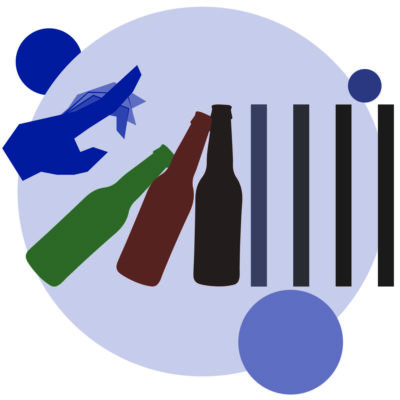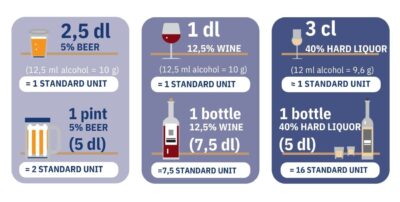 Don’t let alcohol take the wheel
Don’t let alcohol take the wheel
Our bodies do not require alcohol to sustain themselves. Although alcohol is quite high in calories – one gram of alcohol contains 7 calories – it provides no essential nutrients, making it basically worthless for us.
There are four fundamental ways in which people can relate to alcohol. An abstinent (or teetotaller) never drinks at all, a moderate drinker stays within recommended limits, a heavy drinker consumes amounts that pose serious health risks, and an alcohol-dependent individual experiences such severe problems due to drinking that professional therapy is necessary to overcome them. A separate category is the binge drinker, who consumes large amounts of alcohol in a short period with the intent of getting drunk and does so at least once a month.
Most of us believe we drink in moderation and assume we are safe from health risks. However, the true measure is not our subjective perception but the physiological limits of our bodies. Professional recommendations are based on these limits.
Only consume alcohol after the age of 18! Brain maturation, which is negatively impacted by frequent teenage drinking, typically concludes around this age.
For adult men, the recommended maximum intake is two standard drinks per day, while for adult women, it is one standard drink per day, with at least two alcohol-free days per week. Pregnant and breastfeeding women should avoid alcohol entirely, as it can hinder foetal and infant development.
What counts as a standard drink?
A drink containing 10 grams of pure alcohol is considered one standard unit. The servings consumed at home or in bars and restaurants are often larger than one unit (e.g., a pint of beer equals two standard drinks).

A calculator (currently available in Hungarian) on our website can help determine the number of standard drinks in the beverages you consume.
The effects of alcohol depend not only on the amount consumed but also on its absorption and breakdown rate (for example, alcohol enters the bloodstream more slowly when consumed with food).
Blood alcohol level is also influenced by the fact that the liver can only process about 5–8 grams per hour.
Side effects of alcohol consumption
The headache that accompanies a hangover is caused by acetaldehyde, a molecule released during alcohol metabolism. While this unpleasant condition passes relatively quickly, excessive alcohol consumption has numerous negative long-term effects. It deteriorates quality of life and can even shorten the lifespan. Health risks include premature skin aging, weakened immune defences (e.g., increased susceptibility to pneumonia), liver damage, numb limbs, irrational behaviour, erectile dysfunction in men, and developmental disorders in unborn children.
The extent of alcohol’s effects on the body is reflected in blood alcohol levels – the higher the level, the stronger the impact. Our online calculator provides an estimated blood alcohol concentration based on consumption.
If alcohol has so many negative effects, why do we still drink?
To change a habit, it is crucial to understand the motivations behind it. The reasons for alcohol consumption can vary widely and may change over time. In our book Health to Go, we categorize drinking motives based on external/internal and positive/negative reinforcement, resulting in four types:
- External/positive reinforcement: This is social drinking, where a person drinks primarily to enjoy time with friends and loved ones.
- Internal/positive reinforcement: This is the enhancement of positive affect, where someone drinks to seek excitement and intense experiences. These individuals tend to be impulsive, sociable, and open to the world but may also exhibit aggression and loss of self-control.
- Internal/negative reinforcement: This is coping drinking, where consumption is driven by the desire to escape negative emotions such as anxiety, stress, or sadness. People with this motivation often struggle with difficulties in socialization, excessive worry, and low self-esteem.
- External/negative reinforcement: This describes conformity drinking, where individuals consume alcohol due to social pressure. They often drink because their peers encourage them to do so. This can be avoided by learning to say no – whether sincerely, humorously, or with a little white lie (e.g., “I’m on medication right now, so I can’t drink!”).
The most common and influential model (Cooper, 1994) proposes that drinking motives can be described on two dimensions: the first one is related to reinforcement sought from alcohol use (positive or negative), and the second is related to the expected consequences of alcohol consumption (internal or external). The model proposes four drinking motives: coping with negative affect (negative and internal, e.g., “to forget your worries”), conformity with others (negative, external, e.g., “not to be left out”), enhancement of positive affect (positive and internal, e.g., “because it’s fun”), and social experience (positive and external, e.g., “to celebrate a special occasion with a friend”).
Once we recognize our motivations and compare them with our drinking habits, we are on the right path to determining whether we need to adjust our behaviour for our health.
If you suspect that you may be at risk of alcohol abuse, seek guidance from your general practitioner or a psychologist. Additionally, support is available on the following website.
Graphics: Health Promotion Center